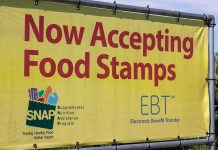
Want SNAP But Aren’t Sure If You Qualify? Here’s How To Tell
(DailyDig.com) – Food insecurity remains a top concern in the United States. The USDA says that 10.5% of all households struggled to access enough food to live a healthy, active lifestyle in 2020. Although there are no simple answers to this ongoing problem, Americans with low incomes who need help have options. While there are many ways that you can seek assistance, the federal government has created some relief programs. The Supplemental Nutrition Assistance Program (SNAP) provides nutrition benefits to needy families who qualify for assistance.
SNAP Explained
SNAP is the new name for the food stamp program that gives households money to buy groceries. Beneficiaries receive benefits on a debit card that they can use at approved locations to purchase approved items.
The SNAP program is only for low-income households with minimal assets. Everyone who eats and prepares meals together is considered part of the household.
Income Guidelines
SNAP defines “income” as any money earned or received by a family member through employment, unemployment benefits, government welfare programs, disability programs, or child support payments. Qualifying households must demonstrate a monthly gross income at or below 130% of the poverty line. Net income must fall at or below the poverty line in most cases.
Households with a person with a disability or a person over the age of 60 are not required to meet the monthly income requirements and only need to meet the net income requirements.
The number of people in a family determines where the poverty line falls. However, the income guidelines are the same in all states except Alaska and Hawaii, which follow a slightly higher threshold.
SNAP may allow some families to deduct allowable expenses from estimated amounts of income, including medical bills and childcare costs. All taxpayers get a 20 percent deduction and a standard deduction that varies by state and family.
Asset Guidelines
“Assets” are items that a household could sell to get money for food. However, the state usually deducts essential items such as the family’s primary residence and personal property. It also sets a value limit for approved assets.
To qualify for the program, households must demonstrate that they have less than $2,500 in total assets at the time of application and during participation. Households with a family member aged 60 or over must meet an asset threshold of $3,750.
Work Requirement
SNAP also has a work requirement. Adults must be actively looking for work, employed, or in job training and may not quit a job or voluntarily reduce their hours while receiving benefits. The program exempts the elderly, pregnant women, and people who cannot work for health reasons.
Automatic Ineligibility
Some people may not qualify for SNAP even if they meet income and asset rules. The government forbids non-citizens, strikers, and some students from participating in the program, no matter how much money they give. Legal immigrants may be eligible if they show they have dependents, are disabled, or have lived in the US for at least five years.
SNAP also accepts limits for adults without minor children who need benefits. If they don’t work, they can only get SNAP for three months every three years. Anyone found abusing the system or defrauding the program is banned for life.
Applying for Benefits
There is no shame in needing assistance. Life can sometimes knock you off your feet, but how you get back up matters. If you or someone you know needs help finding safe and reliable food, SNAP can help. Contact your local SNAP office if you have any questions or would like to begin the application process. Some states may also allow you to apply online or by mail.
Copyright 2022, DailyDig.com













